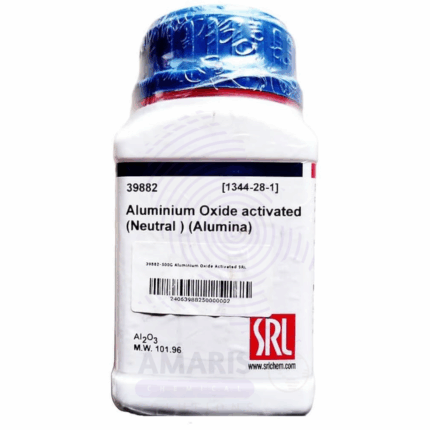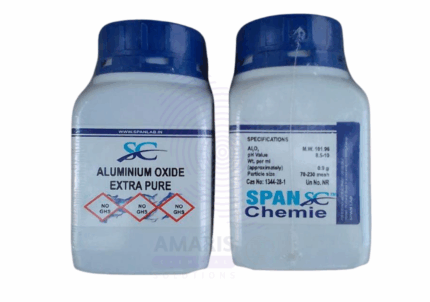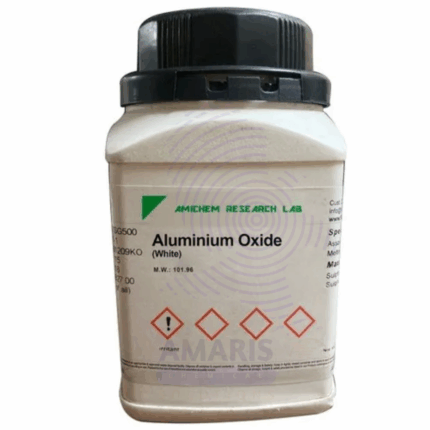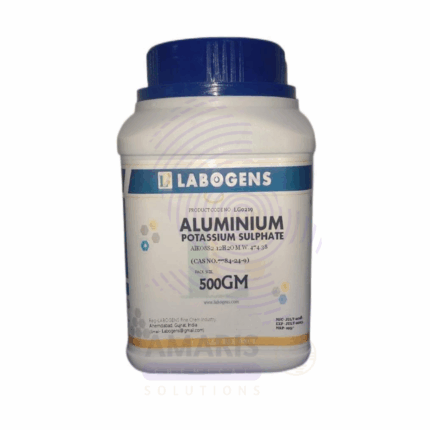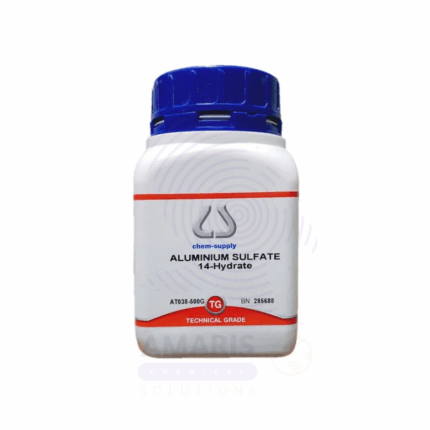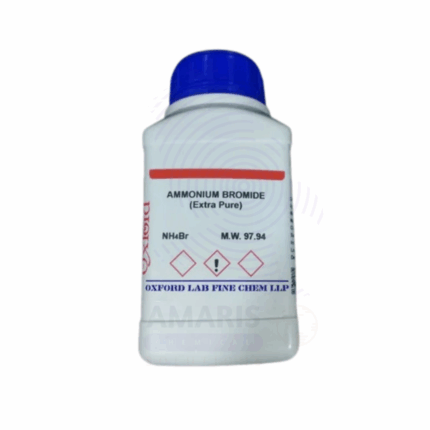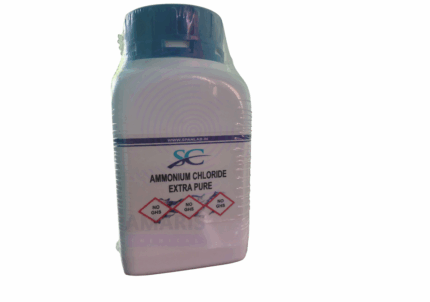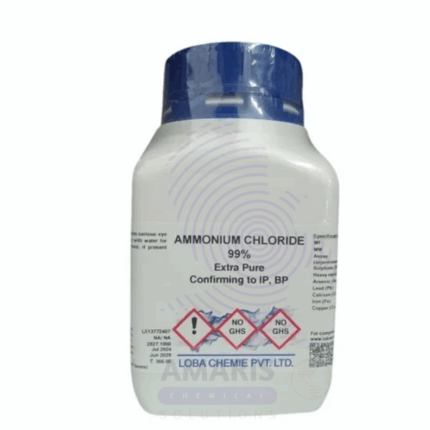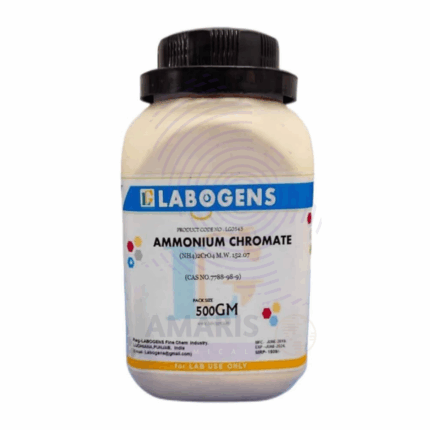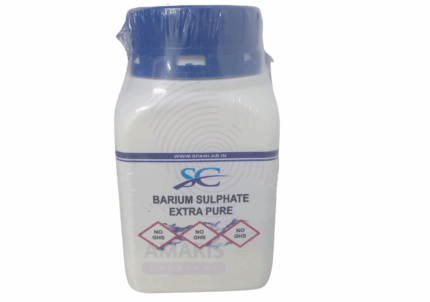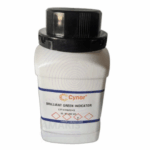
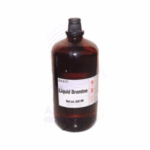
Bromelain Extra Pure
$ 18.00 Original price was: $ 18.00.$ 17.34Current price is: $ 17.34.
Bromelain Extra Pure is a high-purity proteolytic enzyme derived from pineapple, widely used in laboratory research involving protein digestion, enzymatic reactions, and biochemical assays. It is particularly valued for its ability to hydrolyze a broad range of protein substrates, making it useful in studies of protein structure, enzyme kinetics, and tissue dissociation. In pharmaceutical and biomedical laboratories, it is also investigated for its anti-inflammatory, fibrinolytic, and mucolytic properties. The extra pure grade ensures minimal contamination from other enzymes or plant materials, offering consistent and reliable enzymatic activity. Bromelain should be stored in a cool, dry place in tightly sealed containers to maintain its stability and effectiveness.
Bromelain Extra Pure
Primary Uses
- Proteolytic Enzyme Studies
- Used in biochemistry labs to study proteolysis, enzyme kinetics, and protein substrate breakdown, as Bromelain hydrolyzes proteins into peptides and amino acids.
- Tissue Dissociation for Cell Culture
- Applied in cell biology for gentle dissociation of tissues to isolate viable cells, especially where preservation of surface antigens is critical.
- Anti-inflammatory Mechanism Research
- Employed in pharmacology labs to study anti-inflammatory pathways, especially its effects on prostaglandins, bradykinin, and fibrin.
- Allergenicity and Stability Testing
- Utilized in toxicology and allergy studies to evaluate enzymatic allergens and their stability under different conditions.
Secondary Uses
- Model Enzyme in Educational Labs
- Frequently used in teaching labs to demonstrate enzyme activity, temperature/pH dependence, and enzyme inhibition.
- Clarification in Bioprocess Simulation
- Simulates industrial enzymatic treatments, such as in juice clarification, useful for food technology and biotechnology experiments.
- Electrophoresis Sample Prep
- Occasionally used to degrade proteins in samples for preparatory steps before gel electrophoresis or other downstream analysis.
| PACK SIZE |
500 grams Plastic Tin |
|---|
1. Basic Identification Attributes
- Chemical Name: Bromelain
- CAS Number: 9001-00-7
- HS Code: 3507.90.90
- Molecular Formula: Not applicable (complex mixture of enzymes)
- Synonyms: Ananase, Pineapple extract enzyme, Bromelin
- Grade: Extra Pure (for laboratory/research use)
2. Physical & Chemical Properties
- Physical State: Powder
- Color & Odor: Off-white to light yellow, slight characteristic odor
- Solubility in Water: Soluble
- Solubility in Alcohol: Insoluble
- Optimum pH Range: 6.0–7.0
- Isoelectric Point (pI): ~4.6
- Temperature Sensitivity: Denatures above 60°C
- Enzymatic Activity: Measured in GDU/g or MCU/g depending on source
- Boiling/Melting Point: Not applicable (decomposes)
- Stability: Stable under dry, cool storage; loses activity with heat/humidity
3. Safety & Hazard Attributes
- GHS Classification:
- Respiratory Sensitizer (Category 1)
- Skin Sensitizer (Category 1)
- GHS Pictograms: ⚠️
- NFPA Ratings:
- Health: 2
- Flammability: 0
- Reactivity: 0
- Exposure Limits: Not established (avoid inhalation of enzyme dust)
- Inhalation/Ingestion Risks:
- May cause allergic reactions or respiratory irritation
- Skin/Eye Contact:
- May cause irritation or sensitization
4. Storage & Handling Attributes
- Storage Conditions:
- Store in tightly sealed container at 2–8°C
- Protect from moisture and light
- Incompatible Materials:
- Oxidizing agents, acids
- Container Type: Airtight plastic or glass containers
- Shelf Life: 1–2 years under optimal storage
- Special Handling Requirements:
- Use gloves, dust mask, and eye protection in lab
- Work in fume hood if powder handling is frequent
5. Regulatory & Compliance Attributes
- Regulatory Status:
- Not hazardous under normal lab use
- Not intended for therapeutic or food use in this grade
- Hazard Symbols: ⚠️
- Transportation Restrictions: Not regulated for transport
- Waste Disposal Method:
- Dispose of as non-hazardous organic waste
- Avoid environmental release
6. Environmental & Health Impact
- Ecotoxicity:
- Low environmental hazard; biodegradable
- Persistence in Environment:
- Not persistent; degrades in moist environments
- Carcinogenicity/Mutagenicity:
- Not classified as carcinogenic
- Health Concerns:
- Potential allergen via inhalation or skin exposure
SAFETY PRECAUTIONS
- Personal Protective Equipment (PPE):
- Wear lab coat, nitrile gloves, and safety goggles.
- If handling powders, use a dust mask or particulate respirator.
- Handling:
- Avoid generating dust; handle in a fume hood or well-ventilated area.
- Avoid contact with skin, eyes, and clothing.
- Prevent inhalation or ingestion of the enzyme.
- Storage:
- Store in a cool (2–8 °C), dry, and light-protected location.
- Keep the container tightly sealed.
- Avoid exposure to heat and moisture which can degrade enzymatic activity.
- Incompatibilities:
- Strong oxidizers, acids, and bases may denature the enzyme.
FIRST AID MEASURES
- Inhalation:
- Remove victim to fresh air.
- Seek medical attention if breathing becomes difficult or if allergy symptoms occur.
- Skin Contact:
- Wash skin with plenty of water and soap.
- Remove contaminated clothing.
- Seek medical advice if irritation or allergic reaction develops.
- Eye Contact:
- Rinse cautiously with water for several minutes.
- Remove contact lenses if present and easy to do.
- Continue rinsing and seek medical help if irritation persists.
- Ingestion:
- Rinse mouth with water.
- Do not induce vomiting.
- Get medical attention if large amounts are swallowed or if symptoms occur.
FIRE FIGHTING MEASURES
- Extinguishing Media:
- Use water spray, CO₂, foam, or dry chemical powder.
- Hazardous Combustion Products:
- May emit carbon monoxide (CO) and carbon dioxide (CO₂) upon decomposition.
- Protective Equipment for Firefighters:
- Firefighters should wear self-contained breathing apparatus (SCBA) and protective clothing.


 Preservatives(food)
Preservatives(food) Flavor Enhancers
Flavor Enhancers Acidulants
Acidulants Sweeteners
Sweeteners Antioxidants
Antioxidants Colorants(food)
Colorants(food) Nutraceutical Ingredients (food)
Nutraceutical Ingredients (food) Nutrient Supplements
Nutrient Supplements Emulsifiers
Emulsifiers
 Collectors
Collectors Dust Suppressants
Dust Suppressants Explosives and Blasting Agents
Explosives and Blasting Agents Flocculants and Coagulants
Flocculants and Coagulants Frothers
Frothers Leaching Agents
Leaching Agents pH Modifiers
pH Modifiers Precious Metal Extraction Agents
Precious Metal Extraction Agents
 Antioxidants(plastic)
Antioxidants(plastic) Colorants (Pigments, Dyes)
Colorants (Pigments, Dyes) Fillers and Reinforcements
Fillers and Reinforcements Flame Retardants
Flame Retardants Monomers
Monomers Plasticizers
Plasticizers Polymerization Initiators
Polymerization Initiators Stabilizers (UV, Heat)
Stabilizers (UV, Heat)
 Antifoaming Agents
Antifoaming Agents Chelating Agents
Chelating Agents Coagulants and Flocculants
Coagulants and Flocculants Corrosion Inhibitors
Corrosion Inhibitors Disinfectants and Biocides
Disinfectants and Biocides Oxidizing Agents
Oxidizing Agents pH Adjusters
pH Adjusters Scale Inhibitors( water)
Scale Inhibitors( water)
 Antioxidants(cosmetic)
Antioxidants(cosmetic) Emollients
Emollients Fragrances and Essential Oils
Fragrances and Essential Oils Humectants
Humectants Preservatives
Preservatives Surfactants(cosmetic)
Surfactants(cosmetic) Thickeners
Thickeners UV Filters
UV Filters
 Fertilizers
Fertilizers Soil Conditioners
Soil Conditioners Plant Growth Regulators
Plant Growth Regulators Animal Feed Additives
Animal Feed Additives Biostimulants
Biostimulants Pesticides (Herbicides, Insecticides, Fungicides)
Pesticides (Herbicides, Insecticides, Fungicides)
 Active Pharmaceutical Ingredients (APIs)
Active Pharmaceutical Ingredients (APIs) Excipients
Excipients Solvents(pharmaceutical)
Solvents(pharmaceutical) Antibiotics
Antibiotics Antiseptics and Disinfectants
Antiseptics and Disinfectants Vaccine Adjuvants
Vaccine Adjuvants Nutraceutical Ingredients (pharmaceutical)
Nutraceutical Ingredients (pharmaceutical) Analgesics & Antipyretics
Analgesics & Antipyretics
 Analytical Reagents
Analytical Reagents Solvents(lab)
Solvents(lab) Chromatography Chemicals
Chromatography Chemicals Spectroscopy Reagents
Spectroscopy Reagents microbiology-and-cell-culture-reagents
microbiology-and-cell-culture-reagents Molecular Biology Reagents
Molecular Biology Reagents Biochemical Reagents
Biochemical Reagents Inorganic and Organic Standards
Inorganic and Organic Standards Laboratory Safety Chemicals
Laboratory Safety Chemicals Specialty Laboratory Chemicals(Special Laboratory Equipment)
Specialty Laboratory Chemicals(Special Laboratory Equipment)
 Demulsifiers
Demulsifiers Hydraulic Fracturing Fluids
Hydraulic Fracturing Fluids Scale Inhibitors(oil)
Scale Inhibitors(oil) Surfactants(oil)
Surfactants(oil) Drilling Fluids
Drilling Fluids
 Dyes and Pigments
Dyes and Pigments Bleaching Agents
Bleaching Agents Softening Agents
Softening Agents Finishing Agents
Finishing Agents Antistatic Agents
Antistatic Agents
 Admixtures
Admixtures Waterproofing Agents
Waterproofing Agents Sealants and Adhesives
Sealants and Adhesives Curing Compounds
Curing Compounds Concrete Repair Chemicals
Concrete Repair Chemicals Anti-Corrosion Coatings
Anti-Corrosion Coatings
 Surfactants(cleaning)
Surfactants(cleaning) Builders
Builders Enzymes
Enzymes Solvents (Cleaning)
Solvents (Cleaning) Fragrances
Fragrances
 Electronic Chemicals
Electronic Chemicals Catalysts
Catalysts Lubricants
Lubricants Photographic Chemicals
Photographic Chemicals Refrigerants
Refrigerants Automotive chemicals
Automotive chemicals Pyrotechnic Chemicals
Pyrotechnic Chemicals
 Biodegradable Surfactants
Biodegradable Surfactants Bio-based Solvents
Bio-based Solvents Renewable Polymers
Renewable Polymers Carbon Capture Chemicals
Carbon Capture Chemicals Wastewater Treatment Chemicals
Wastewater Treatment Chemicals
 Pigments
Pigments Solvents(paint)
Solvents(paint) Specialty Coatings
Specialty Coatings Binders/Resins
Binders/Resins Additives
Additives Driers
Driers Anti-Corrosion Agents
Anti-Corrosion Agents Functional Coatings
Functional Coatings Application-Specific Coatings
Application-Specific Coatings
 Fresh Herbs
Fresh Herbs Ground Spices
Ground Spices Whole Spices
Whole Spices Spice Blends
Spice Blends Dried Herbs
Dried Herbs
 Leavening Agents
Leavening Agents Dough Conditioners
Dough Conditioners Flour Treatments
Flour Treatments Fat Replacers
Fat Replacers Decoratives
Decoratives Preservatives(baking)
Preservatives(baking)
 Plasticizers & Softeners
Plasticizers & Softeners Reinforcing Agents
Reinforcing Agents Adhesion Promoters
Adhesion Promoters Vulcanizing Agents
Vulcanizing Agents Antidegradants
Antidegradants Blowing Agents
Blowing Agents Fillers & Extenders
Fillers & Extenders Accelerators & Retarders
Accelerators & Retarders

